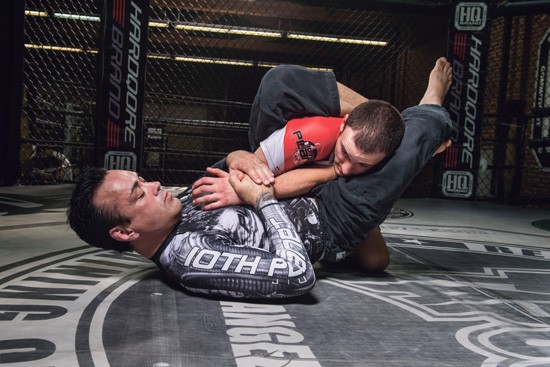
A shirtless Eddie Bravo stood on one end of the jiu jitsu mat inside the Ginásio do Ibirapuera sports arena in São Paulo, Brazil, stared straight ahead, then walked toward his destiny.
It was May 17, 2003, the quarterfinal match in the 66-kilogram division of the Abu Dhabi Combat Club (ADCC) Submission Wrestling World Championship, one of the biggest challenges of its kind. Fans had gathered to cheer on masters of jiu jitsu, judo, wrestling and other grappling arts in a rare interdisciplinary tournament, a real-life Bloodsport. Bravo had turned 33 two days earlier, and this was his present: his first international professional tournament; his first matches on foreign soil; and a hostile crowd rooting for the guy across the mat from him, three-time defending champion Royler Gracie, scion of the family who essentially created Brazilian jiu jitsu. No member of the clan had ever lost to an American, certainly not in a competition broadcast on national television. Certainly not to an undersized Mexican kid from Santa Ana.
]
To the audience, Bravo was just another pretender–a brown belt, at that–who wasn't particularly good at the traditional method of jiu jitsu, with its stylized moves emphasizing grips on a gi (the sport's uniform) to gain leverage over opponents. But Bravo had a trump card: a style of his own, developed over thousands of hours of training that incorporated jiu jitsu techniques with tactics people might use in a real fight, not in a kimono-grabbing contest.
Trainers and fighters had little idea who Bravo was, and the ADCC tournament was stocked with legends–but Bravo was ready. He upset former jiu jitsu champion Gustavo Dantas in the opening round of the tournament with a rear naked choke, squeezing Dantas into submission. Now, he stood facing Gracie.
“Royler was a hero of mine,” Bravo says now, more than a decade later. “It was like being inside of a 3-D TV or something. It was surreal and weird, but I was confident. He didn't look that strong, and I was used to going against [muscular] wrestlers, so any time I got to go against someone my size, I was confident.”
The face-off began. Bravo dropped to one knee in a half-guard position to better trap one of Gracie's legs. Gracie cautiously circled around him for a minute, looking for a way to blast through the American's defense. Then Bravo trapped his leg, and the two men dropped onto the mat. For the next eight minutes, they battled fiercely as they writhed about the mat, limbs locking and flailing to gain some, any advantage over each other. Gracie controlled Bravo through most of the match, with Bravo seemingly gripping on for dear life.
As the seconds ticked away, Bravo realized he had to make something happen or he'd lose. He decided to debut one of his unorthodox moves, one he had developed for months: the Rubber Guard, in which he'd hold one of his legs across the back of Gracie's neck to break the Brazilian's posture. The champ broke right through his Rubber Guard, but Bravo recovered and managed to figure-four his legs around Gracie's neck and apply a triangle choke. Bravo vised his legs together, trying to cut off Gracie's blood and air. When that crushing pressure wasn't enough, Bravo grabbed the back of Gracie's head and pulled him farther down into the triangle of his legs. A few seconds later, the most accomplished member of jiu jitsu's first family frantically tapped his hand to signal he was done.
Boos erupted from the crowd, as a stunned Bravo strutted in triumph around the mat before collapsing into a sobbing heap in the middle. A reporter tried to interview him, but Bravo was inconsolable. “He's a legend,” Bravo muttered. “I can't believe I won. I can't believe I won.”
Bravo would go on to lose a semifinal match, but it didn't matter: He was the first American to beat a Gracie, and his legend was secure.
And then Bravo stunned the jiu jitsu world by retiring from competition.
He wasn't done with the sport, though. He opened a school in Los Angeles to teach his new system, 10th Planet Jiu Jitsu. It became the first well-known jiu jitsu program based entirely around training without wearing a gi, an innovation that led to the genre's revival in mixed martial arts (MMA), where conventional jiu jitsu fighters had gone from a dominating force in the sport's early days to a struggling minority.
Many jiu jitsu traditionalists and MMA aficionados think Bravo's system all bluster and no substance, and they think less of the man himself, not just for his moves, but also for his open love of pot, his celebrity friends and for besmirching their sport with upstarts who think they can take on anyone because they learned from the Man Who Took Down Gracie. But in the past decade, 10th Planet has expanded worldwide, with academies across the U.S.–including Costa Mesa and Buena Park–as well as locations in Europe, Asia, South America, Mexico and Australia. And his fighters are dominating opponents with their professor's style, bringing more acolytes into the fold.
“I don't think I even have to prove the effectiveness of my system anymore,” Bravo says. “I pass it along to the MMA fighters, and they go out and prove its effectiveness in their fights.”
Story continues on Page 2.
[
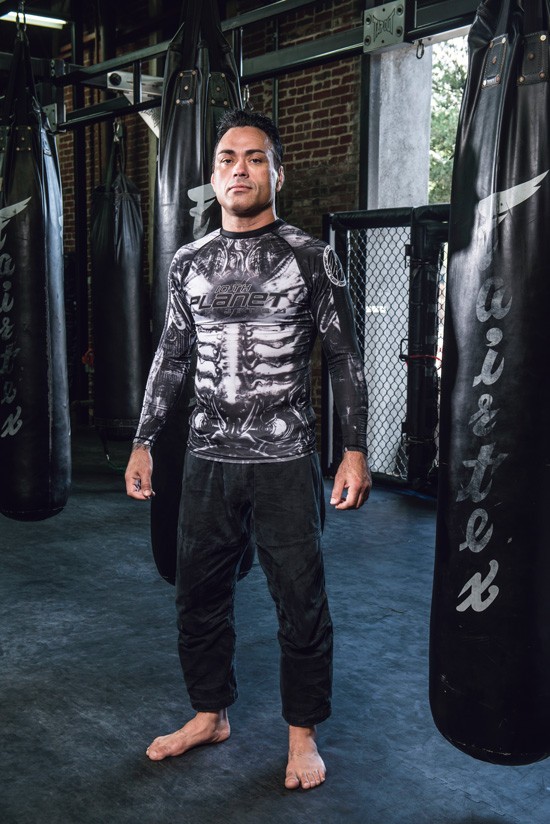
It's 10:30 p.m. on a Wednesday, and Bravo is sitting against the chain-link fence that sections off the jiu jitsu mat from the rest of the HardQore Brand Training Center near downtown LA. He's exhausted, but his eyes are wide, and his excited voice carries across the large building. Bravo adjusts the cuff of his long-sleeved rashguard (a jiu jitsu training shirt) to cover up the end of his colorful tattoo sleeves and loosens the strap on his protective headgear. In front of him, a few dozen students get in one last round of training. The 5-foot-8 Bravo isn't as large as many of the other guys on the mat, but he dominates the room.
“All right, guys, wrap it up! They're kicking us out!” Bravo shouts to his class.
Every type of jiu jitsu practitioner is here, from amateurs to professionals, white and black belts. They're doing Bravo's moves, all featuring names out of a Hasbro game: the Rubber Guard, the Twister, the Lockdown, Dead Orchard and more. The students haven't stopped going through drills and squaring off for at least two hours, several of them were here the day before, and many of them will return the next day. Some of the students have been with Bravo for years; others are just training with him for a week while they're on vacation. No one wants to miss a minute with their famous professor.
Not bad for a guy who originally wanted to make it big in music.
Bravo was born Edgar Cano in 1970 in Santa Ana–“where all the Mexican servant workers and gardeners lived,” he cracks. When he was 10, his stepfather left his mother, and his now-single mom had to raise three children on a salary of roughly $150 per week. To help make ends meet, Bravo became an entrepreneur early on, stealing pencils to sell at school at a dime apiece, then working at a swap-meet stand selling underwear and socks when he was 14.
Even then, he was an outsider, ridiculed by others for supposedly “trying to act white because I listened to Ozzy [Osbourne].” Bravo briefly wrestled at Santa Ana High School before transferring to Santiago High School in Garden Grove. At 21, Bravo left for Hollywood “with rock-star dreams,” getting gigs as a DJ at strip clubs while playing guitar and singing for a rock band. While there, he decided to learn karate as a way to lose pounds because Bravo couldn't stand traditional weight-room workouts, as well as because he'd always been a big fan of Bruce Lee.
“The real Bruce Lee was even more fascinating than the movie Bruce Lee,” Bravo says. “He truly had an open mind, and he broke through the chains of tradition in martial arts. He had so many powerful quotes. He was like Buddha, but as a martial artist.”
Karate didn't maintain Bravo's interest for long, though. In 1994, he watched tape of Royce Gracie (Royler's brother) easily beating his opponents in one of the first sanctioned Ultimate Fighting Championship (UFC) tournaments. He was one of MMA's early superstars, confounding American audiences by breezing through matches despite being smaller and looking weaker than many of his opponents. His secret was the jiu jitsu style his family had perfected in Brazil for decades, with a grappling technique that meant once Gracie took down an opponent, submission was just a couple of brutally effective twists away.
Bravo wasn't looking to become a professional then; he just wanted to train in the most effective martial art, and Gracie's dominance convinced Bravo that jiu jitsu was it. He signed up to learn from Jean Jacques Machado, himself a jiu jitsu legend and cousin of the Gracies.
Machado had his own notoriety: One of his hands is missing fingers, a virtual death sentence in a sport in which grabbing an opponent's gi is essential to succeeding. But Machado compensated for that seeming handicap by developing his own style to make opponents submit with ease, becoming a world champion in the process.
“From the time I was a white belt, I never wanted my black belt from anyone else, only Jean Jacques Machado,” Bravo says. “He helped me along my unorthodox path. My system has his fingerprints all over it.”
“He was training at least three days per week–and with other students on days when the gym was closed,” Machado says. “Eddie was one of the most loyal students I've ever had.”
While Bravo appreciated his tutelage under Machado, he ultimately felt jiu jitsu itself was finite. Bravo's initial interest in jiu jitsu sprang from MMA, and the sport's submission moves had always been a major part of MMA's repertoire, along with boxing, wrestling, Muay Thai and other fighting styles. But MMA fighters quickly realized that learning just enough defensive jiu jitsu could stop its specialists cold, and many of jiu jitsu's traditional techniques didn't work well for smaller fighters such as Bravo. He began thinking of new moves or new takes on old moves, and then experimented with them in training, seeking Machado's guidance whenever he got stuck.
Machado says that Bravo's dedication to the sport and his creativity were the two things that made him stand out among other students, and they were ultimately what led him to compete, beginning as a blue belt in 1996, the second-lowest rank in the jiu jitsu world.
“I try to help anyone who comes up to me with an idea,” Machado says. “With Eddie, some students thought his ideas were crazy. I didn't take away any of his ideas or positions, I just helped with the effectiveness of them.”
These new offensive techniques wowed Bravo's fellow classmates, but he found himself acting much more conservatively in tournaments, leaving his secret moves in the gym. But once he gained the confidence to use more offense in competition, Bravo tore through amateur competitions at every level from his time as a blue belt until his trip to the ADCC national qualifiers in late 2002. His new style focused on using leverage and movement against a stronger opponent and emphasized moves that didn't rely on grasping onto a gi, which caught opponents off-guard. Such a style also prepared him for no-gi tournaments such as those put on by ADCC. At the ADCC qualifiers, he took out some of America's top grapplers to earn his trip to Brazil.
[
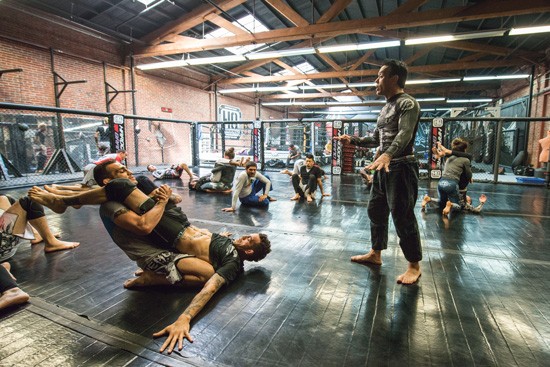
Following the 2003 ADCC tournament, Bravo retired from professional jiu jitsu. He was so committed to his style, so sure it could transfer over to the more lucrative world of MMA, that coaching seemed more appealing than continuing to fight. Upon returning to Southern California, he opened 10th Planet gym, the original location of which operates as his empire's headquarters.
“I've always been obsessed with making jiu jitsu as MMA-ready as possible,” Bravo says. “I never wanted to do MMA, but I always thought that if my back was against the wall, I would do it over working a normal job. I wanted to be ready in case I had to switch to MMA. Thankfully, I never had to.”
At 10th Planet, Bravo began teaching and refining his style, quickly gaining a following not only for his coaching, but also for his eccentricities. Along with creating new moves, he gave them bizarre names–the aforementioned Twister and Rubber Guard, plus Crackhead Control (a move that prevents an opponent from standing up) and Muddy Waters. “I think of it as they're a lot like the names of rock bands. They're stupid, but they stick around,” Bravo explains. “Smashing Pumpkins is such a stupid name. If someone came up to you and said they wanted to call their band Smashing Pumpkins, you'd tell them that's, like, the stupidest name ever. But they're Smashing Pumpkins, it's who they are, and it stuck.”
And unlike many jiu jitsu coaches who zealously guard their drills, Bravo gave it all away through his website. “I don't mind people seeing the techniques and learning about the system,” Bravo says, “because I know that anyone who's going to try to study it to beat it is going to end up converting to it themselves.”
The 10th Planet movement has exploded since he opened the original gym. Its logo, a planetary sphere, is on everything from hoodies and T-shirts to rashguards, tights and MMA trunks. Bravo has written four books, put out two DVD sets, and distributes numerous videos online of his techniques and seminars around the world.
More important, Bravo's students are making their presence felt in the UFC, his offense-oriented attacks making jiu jitsu a formidable weapon in a way not seen since the days of Royce Gracie. Current devotees include The Ultimate Fighter winners Tony Ferguson and Kelvin Gastelum, as well as Ben Saunders, Alan Jouban and Jessamyn Duke. Bravo's students, much like their coach, also have a knack for creating history: Last year, Saunders pulled off the first omoplata (a shoulder lock using the legs and hips to crank the opponent's arm) in UFC history. The performance won Submission of the Year from several MMA news outlets and is regarded as a historic moment for jiu jitsu's place in the sport.
“Honestly, everything about his system is so unique, I think people would have to really study his system to teach his system,” says Saunders, a welterweight. He spends much of his time training with American Top Team in Florida, but he makes it a point to fly out to LA to work with Bravo during his camps. “I'm just out here trying to be a sponge and soaking up all of this information.”
“Eddie's just a total badass,” says Ferguson, a lightweight who has begun his UFC career with a 7-1 run, including a Submission of the Night award. “He has changed the whole game for jiu jitsu in MMA. He has his system, and it works. I'm not the only one who it works for.
Regardless of if you like him or not, you know who he is, and you have to respect him.”
“I take what I feel applies best to MMA and practice those the most,” the welterweight Jouban says. “Eddie is a jiu jitsu fanatic. I appreciate that about him. He's not trying to get me in shape or show me some new kicks or spin moves. I go to him because I want the best jiu jitsu, and that's what I get.”
Other Bravo students have been high-profile fighters, including former UFC light heavyweight champion Chuck Liddell. But his most famous student is UFC commentator and comedian Joe Rogan.
“Sometimes, he's a misunderstood guy because he gets so fanatical and obsessed about jiu jitsu that it tweaks people one way or the other,” Rogan says. “Either they think he's an inspiration and become one of his devoted students or fanatical admirers, or they think he thinks he knows it all and has a tremendous ego. That's not it, though: He has a deep connection to jiu jitsu, and he teaches other techniques in class, too, and then he'll give everyone the name of the person whose technique it is.”
Rogan met Bravo when they were both students at Machado's dojo. The two began training and spending time together in and out of the gym, and although Bravo pointed out that Rogan hasn't trained with him in quite some time, they still consider themselves close friends. Aside from the jiu jitsu bonds, Bravo also turned Rogan on to a longtime passion of his: weed.
Bravo had always been one of the strongest voices in MMA and jiu jitsu openly advocating for legalization and blasting the Drug War, much to the chagrin of some of the sports' guardians, who preach a clean-living outlook. Rogan was initially skeptical of Bravo's enthusiasm. “I always thought pot was for idiots or for people who were looking to escape reality,” Rogan says. “And Eddie said he used to think that, too, but he was really adamant about how powerful marijuana can be.”
Now, Rogan also advocates for legalization–an impressive achievement for Bravo because his close friend is “the guy who calls all of the UFC fights, and he used to be the Fear Factor guy,” and thus is a far more powerful mainstream voice than Bravo is.
“I think pot is one of the reasons Eddie's jiu jitsu is so good,” Rogan says. “He's such a creative guy, and he just looks at things differently. . . . I'm not just saying this because he's my friend. I really, truly believe that he is the most innovative martial artist, period. What he's done is very revolutionary.”
[
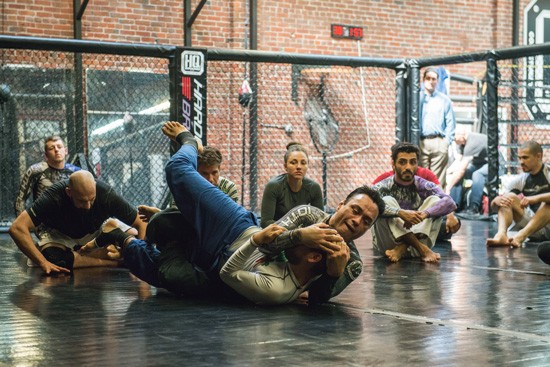
In March 2014, Bravo found himself staring at Royler Gracie across the mat again.
The occasion was Metamoris 3, a Brazilian jiu jitsu bill organized by Ralek Gracie, nephew of Royler. The venue was smaller this time–the Petersen Automotive Museum in Los Angeles–but the atmosphere was no less tense than it was a decade earlier, when they first faced off. The nearly 50-year-old Gracie came out of retirement (which happened right after losing to Bravo) to avenge a defeat he believes to this day came only because of his mistake; Bravo returned to show his victory wasn't a fluke.
There were no dramatic finishes this time: The 20-minute submission-only match ended in a draw. Bravo appeared to have Gracie in more trouble throughout the contest, but he also spent a good portion of the match being smothered by the Brazilian. Yet it was Gracie's brother Royce who couldn't shake Bravo just months later.
“With Eddie Bravo, it's personal,” he said on an episode of the MMA Hour last October. “Do this 'Rubber Guard' stuff, and I'll punch you in the nose.” He went on to explain that while he now grudgingly respects Bravo's jiu jitsu, his bigger issue is the American's personal life and what it means to the sport's next generation.
“You're going to send your kids to learn from a guy who tells everybody it's okay to do drugs? It's okay to drink alcohol?” Royce seethed. “If you want to do it in private, do it in private. I have no problem with that, but I can never send my kid to someone who praises alcohol and drugs. Is that what you want your kids to learn? It's okay to smoke pot?”
According to Bravo, Royce immediately accused him of disrespecting the Gracies after the rematch with Royler, but Bravo says he has “given nothing but respect to the Gracie family.” In the wake of those accusations, Bravo believes Gracie attacked his marijuana use as a distraction.
“He may be right, though; maybe I am a bad role model,” Bravo says. “Depends on how you define a bad role model, I guess, and what you really know about the power of cannabis.”
Bravo currently has no plan to compete in the future, but with the rise of Metamoris (whose organizers are looking to bring competitive grappling to the mainstream), he admits that anything is possible. Besides, he's busy with other stuff. Bravo has gained a following outside of the MMA world by putting up original music, covers and remixes on SoundCloud. There's now a podcast, Eddie Bravo Radio, in which he hosts guests from MMA, jiu jitsu, music and more. He's collaborating with Danny Lohner from Nine Inch Nails on original music. And in 2012, he became a dad to his first son, Draco Lee Bravo.
“I was just a poor Mexican kid from Santa Ana with rock-star dreams,” Bravo says, as students leave for the night. “Jiu jitsu shows you that you can do anything in life. Anything is possible.”
Follow OC Weekly on Twitter @ocweekly or on Facebook!
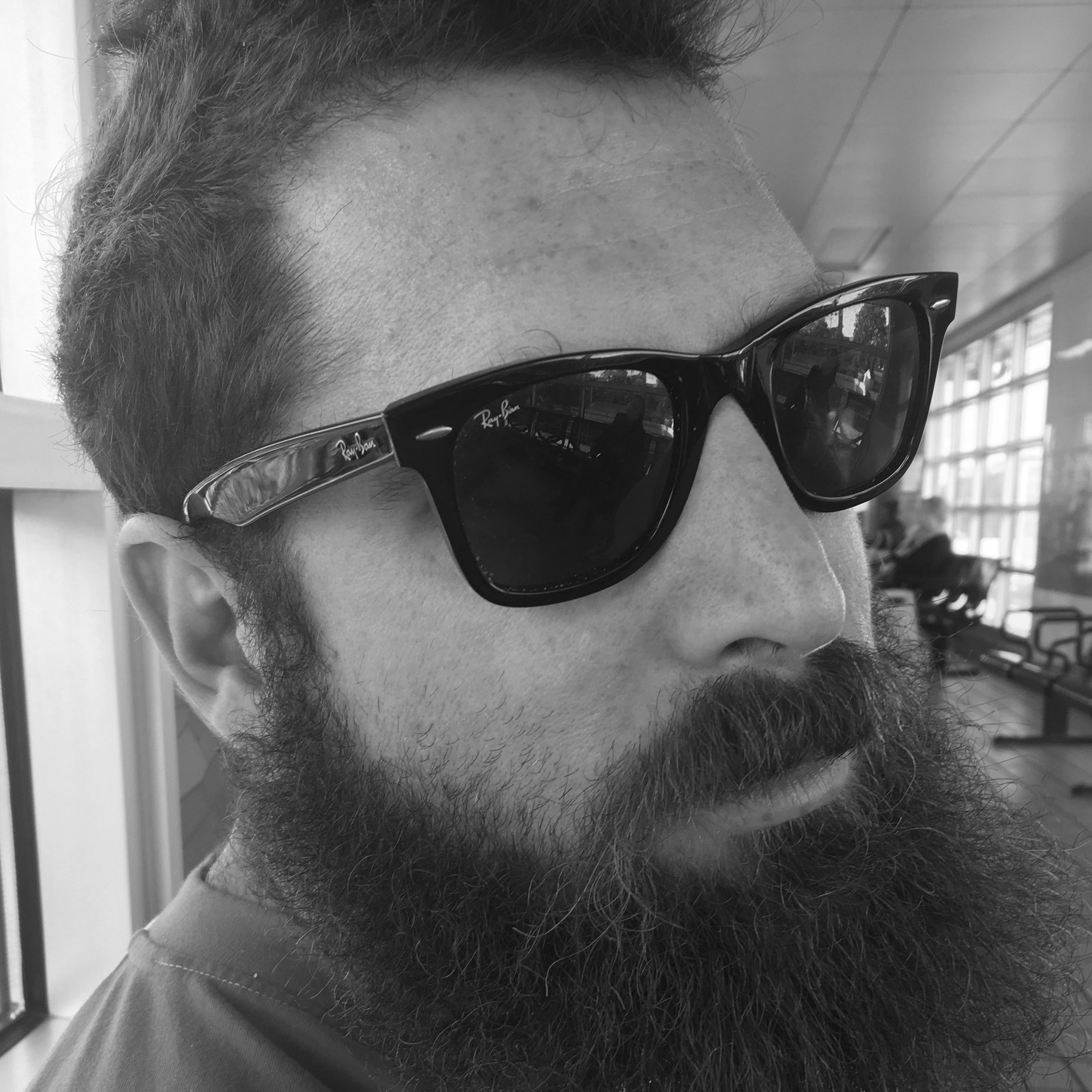
Josh Chesler used to play baseball for some pretty cool teams, but now he just writes about awesome stuff like tattoos, music, MMA and sneakers. He enjoys injuring himself by skateboarding, training for fights, and playing musical instruments in his off time.

